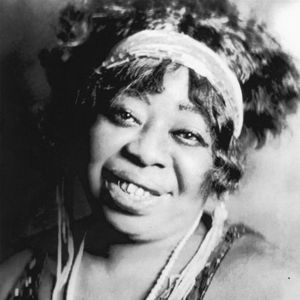
Photo courtesy of the National Women’s History Museum.
Often called the “Mother of the Blues,” Gertrude Malissa Nix Pridgett, better known as “Ma” Rainey, was born on April 26, 1886, in Columbus, Georgia. The daughter of minstrel troupers, and granddaughter of singers, Rainey was a natural on stage. She made her first stage appearance at the Springer Opera House in Columbus when she was just 14 years-old. Soon after her time on the stage in Columbus, she began touring with a number of traveling tent shows and vaudeville acts.
In 1904, Rainey married William “Pa” Rainey, a comedic song writer and performer. Together they toured Southern tent shows and cabarets as “Ma” and “Pa” Rainey. Together they would perform with a band that included drums, violin, bass, and trumpet. It was from these tours that “Ma” was introduced to authentic country blues music, an emerging style at the time, which she began incorporating into her music. She had a talent for capturing the mood and essence of the Black rural southern life, and was the first entertainer to truly bridge the divide between vaudeville, which catered largely to white audiences and developed out of the minstrel shows of the mid-1800s, and authentic Black Southern folk expression.
The 1920s saw the creation of the music recording industry, and in 1923 Rainey recorded her first songs for the Paramount Company. She recorded songs such as “Moonshine Blues” with Lovie Austin, “Yonder Comes the Blues” with Louis Armstrong, and “See See Rider,” which went on to become one of the most famous and recorded blues songs with over 100 versions to date. She had already established herself as a reputable musician with her raspy, deep voice and timbre. She enraptured audiences wherever she went, and her recording career only helped her gain popularity. She would go on to record over 100 songs, many of them dealing with subjects of love and sexuality. Rainey was unapologetic about her bisexuality and often included hidden, and not-so-hidden, references to same-sex relationships in her music. The content of her music would earn her the nickname “Madam Rainey.”
As the 1920s ended, Rainey’s career began to slow down. The Great Depression led to the downfall of the music industry at the time, and when Paramount went bankrupt in 1932, Rainey’s time with the label also ended. Rainey returned to Georgia, splitting her time between Columbus and Rome, and opened a string of theaters, one of which, the Liberty Theater and Cultural Center, still hosts performers and stage plays today.
Rainey passed away of a heart attack on December 22, 1939, in Rome, Georgia, and was laid to rest at Porterdale Cemetery in Columbus, Georgia. Her legacy, however, lives on even today. Not only is she credited as the person who coined the term “blue” for the music she sang, artists such as Janis Joplin and Bonnie Raitt have named Rainey as a major influence on their music. She also inspired poets such as Langston Hughes and Sterling Brown who both wrote and spoke highly of her influence. Alice Walker also looked to Rainey’s music as a cultural model while writing her Pulitzer Prize-winning novel, The Color Purple. In 1982, playwright August Wilson wrote a play about Rainey titled, Ma Rainey’s Black Bottom. The play, a Broadway success, was turned into a Netflix film in 2020 starring Viola Davis and Chadwick Boseman. In 1983, she was inducted into the Blues Foundation’s Blues Hall of Fame, followed 7 years later in 1990 by an induction into the Rock and Roll Hall of Fame. Her achievements did not stop there, however. In 1992 she was inducted into the Georgia Music Hall of Fame, in 1993 she was honored by Georgia Women of Achievement, and in 1994, the United States Postal Service issued a stamp in her honor. Her legacy will continue to live on in the students that attend the Rainey-McCullers School of the Arts which, in part, bears her name helping cultivate new generations of artists.
“Ma” Rainey revolutionized music, helping create and disperse a new style unlike anything people had experienced before. She was unapologetically herself, and an excellent businesswoman who helped bring the stories and realities of Southern Black living to people around the country. She was a woman beyond her time, and her legacy is one that will live on for years to come.
References:
Biography.com (2022). Ma Rainey biography. Biography, A&E, biography.com/musicians/ma-rainey
Brandman, M. (2021). Gertrude ‘Ma’ Rainey. National Women’s History Museum, https://www.womenshistory.org/education-resources/biographies/gertrude-ma-rainey
Chow, A. R. (2020, December 18). Ma Rainey’s black bottom: The true story of Rainey’s legacy. Time, https://time.com/5923096/ma-rainey-true-story/
Muhammad, L. (2020, December 18). Who is Ma Rainey? How the “Mother of the Blues” became an icon. Entertainment Tonight, https://www.etonline.com/who-is-ma-rainey-how-the-mother-of-the-blues-became-an-icon-157871
Orr, N. L. (2021). Gertrude “Ma” Rainey. New Georgia Encyclopedia, https://www.georgiaencyclopedia.org/articles/arts-culture/gertrude-ma-rainey-1886-1939/
Rainey-McCullers School of the Arts (n.d.). History. https://rmsota.org/index.php/history/
Russonello, G. (2019, June 12). Overlooked no more: Ma Rainey, the ‘Mother of the Blues.’ The New York Times, https://www.nytimes.com/2019/06/12/obituaries/ma-rainey-overlooked.html
White, A. (n.d.). Blues locations – Georgia – Columbus. Earlyblues.org, http://earlyblues.org/blues-locations-georgia-columbus/